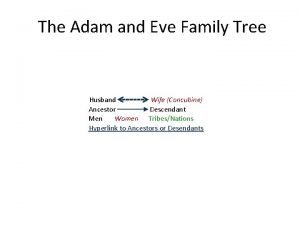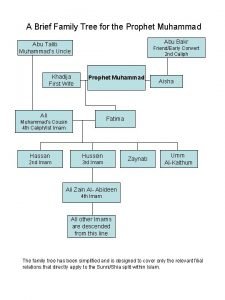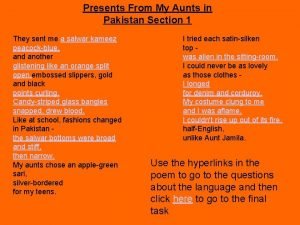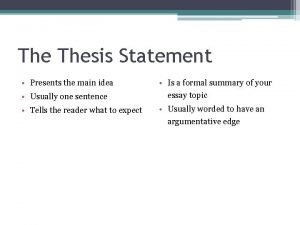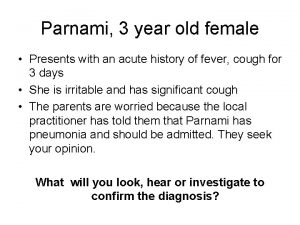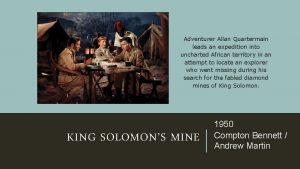Discovery and Adventurer Family Network Presents How Children




























- Slides: 28

Discovery and Adventurer Family Network Presents How Children Differ: Temperament & Personality

“Every child brought into the world increases the responsibility of the parents. . Their dispositions, their tendencies, their traits of character are to be studied. Very carefully should the discriminating powers of the parents be educated, that they may be enabled to repress the wrong tendencies and encourage right impressions and correct principles. Violence or harshness is not required in this work. Self-control must be cultivated and leave its impression on the mind and heart of the child. ” Child Guidance, p. 205

What Is Temperament? • A Set of Inborn Traits • It Does Not Dictate What You Do • It Influences How You Do It • It Can Be Directed Positively or Negatively

The Nine Temperament Traits . . . Or Sedentary? On the go. . . Activity Level

The Nine Temperament Traits Distracted or Attentive? Distractibility

The Nine Temperament Traits . . . Or Calm? Intense. . . Intensity

The Nine Temperament Traits . . . Or Unpredictable? Predictable. . . Regularity

The Nine Temperament Traits Sensory Threshold

The Nine Temperament Traits Extrovert. . . Introvert? Approach/Withdrawal

The Nine Temperament Traits Easily Adaptable. . . Or Slow to Adapt? Adaptability

The Nine Temperament Traits Persistence

The Nine Temperament Traits Half Full. . . Or Half Empty? Mood

The 3 Basic Types of Temperament • Easy – Tranquil, Calm, Consistently Easy to Comfort 40% • Difficult – Fussy, Hard to Satisfy & Comfort, Anxious 10% • Slow to Warm Up – Timid, Reluctant, Wary of New Experiences 15%

What Is Personality? • Combination of Nature & Nurture • Developed Over Time • Foundation for Character Development • Influenced by Many Factors Birth Order, Family Size, Life Events, Serious Ilnesses, Deaths, Family Moves, Economic Status, Gender, Inteligence, Age, Health, Parenting

The 5 Factor Model of Personality OCEAN OR CANOE

The 5 Factor Model of Personality • I have a rich vocabulary. • I have a vivid imagination. • I have excellent ideas. • I spend time reflecting on things. • I use difficult words. • I am not interested in abstractions. (reversed) • I do not have a good imagination. (reversed) • I have difficulty understanding abstract ideas. (reversed) Openness

The 5 Factor Model of Personality Conscientiousness • I am always prepared. • I am exacting in my work. • I follow a schedule. • I get chores done right away. • I like order. • I pay attention to details. • I leave my belongings around. (reversed) • I make a mess of things. (reversed) • I often forget to put things back in their proper place. (reversed) • I shirk my duties. (reversed)

The 5 Factor Model of Personality • I am the life of the party. • I don't mind being the center of attention. • I feel comfortable around people. • I start conversations. • I talk to a lot of different people at parties. • I am quiet around strangers. (reversed) • I don't like to draw attention to myself. (reversed) • I don't talk a lot. (reversed) • I have little to say. (reversed) Extroversion

The 5 Factor Model of Personality • I am interested in people. • I feel others’ emotions. • I have a soft heart. • I make people feel at ease. • I sympathize with others’ feelings. • I take time out for others. • I am not interested in other people’s problems. (reversed) • I am not really interested in others. (reversed) • I feel little concern for others. (reversed) • I insult people. (reversed) • I like being isolated. (reversed) Agreeableness

The 5 Factor Model of Personality • I am easily disturbed. • I change my mood a lot. • I get irritated easily. • I get stressed out easily. • I get upset easily. • I have frequent mood swings. • I often feel blue. • I worry about things. • I am relaxed most of the time. (reversed) • I seldom feel blue. (reversed) Neuroticism

Realistic Expectations • Differentiate Childish Behavior from Challenging Temperament • Differentiate Tired Irritability from Negative Behavior Traits • Make sure you are not the problem by the way you react • Don’t discourage seemingly difficult temperament traits in adult life (persistence) They may prove valuable

Avoiding Labels “Bully” “Four Eyes” “Book Worm” “Class Clown”

Making Adjustments. . . Or Away At Home. . .

Coping with Your Child’s Personality Parenting Strategies For Very Intense Children: • Provide activities that are soothing. • Recognize cues that signal that intensity is rising. • Help child learn to recognize cues that signal that intensity is rising. • Use humor to diffuse intensity. • Teach child to use time-out as a time to calm self-down. • Avoid escalating intensity of child by reacting intensely. • Give calm, clear, brief feedback.

Coping with Your Child’s Personality Slow-to-Adapt Children: Parenting Strategies for • Establish clear routines. • Prepare child by discussing plans for the day when routine changes. • Prepare child for transitions. • Give warnings a few minutes before transition between activities. • Allow time for closure of one activity before going on to next. • Stay aware of number of transitions required. • Keep transitions to minimum if possible.

Coping with Your Child’s Personality Things to Remember • Become a Manager of Your Child’s Temperament • Prepare by Pre-planning • Learn to Distinguish Between Temperament and Learned Behavior • Help Your Child Understand Their Temperament • Teach Your Child that He/She is Precious to God

A Final Thought “Everything leaves its impress upon their minds -- the countenances they look upon, the voices they hear, the places they visit, the company they keep, and the books they read. It is impossible to overestimate the importance for this world and the next of the associations we choose for ourselves and, more especially, for our children. ” Adventist Home, p. 459

 Adventurer basic staff training
Adventurer basic staff training Pathfinder investiture charge
Pathfinder investiture charge Odor
Odor Adam and eve family tree
Adam and eve family tree Children and family services los angeles
Children and family services los angeles Downderry children's and family centre
Downderry children's and family centre Entuity network discovery
Entuity network discovery Rainbow cause and effect
Rainbow cause and effect Prose writing that presents and explains ideas
Prose writing that presents and explains ideas Prose writing that presents and explains ideas
Prose writing that presents and explains ideas What is the structure of drama
What is the structure of drama Chacha of hazrat muhammad
Chacha of hazrat muhammad Presents from my aunts in pakistan
Presents from my aunts in pakistan Presents from my aunts in pakistan poem analysis
Presents from my aunts in pakistan poem analysis Business agility metrics
Business agility metrics 16 3 darwin presents his case answer key
16 3 darwin presents his case answer key 16 3 darwin presents his case answer key
16 3 darwin presents his case answer key Sats word problems
Sats word problems Sue palmer explanation text
Sue palmer explanation text Zids and zods answers
Zids and zods answers Gurmit paid £21 for five presents
Gurmit paid £21 for five presents Nollaig shona meaning
Nollaig shona meaning Pour cet immense bonheur alléluia
Pour cet immense bonheur alléluia Thesis statement and main idea
Thesis statement and main idea A 26 year old female presents
A 26 year old female presents This presents
This presents A dramatic work that presents the downfall of a character
A dramatic work that presents the downfall of a character The text presents
The text presents Presents simple
Presents simple



